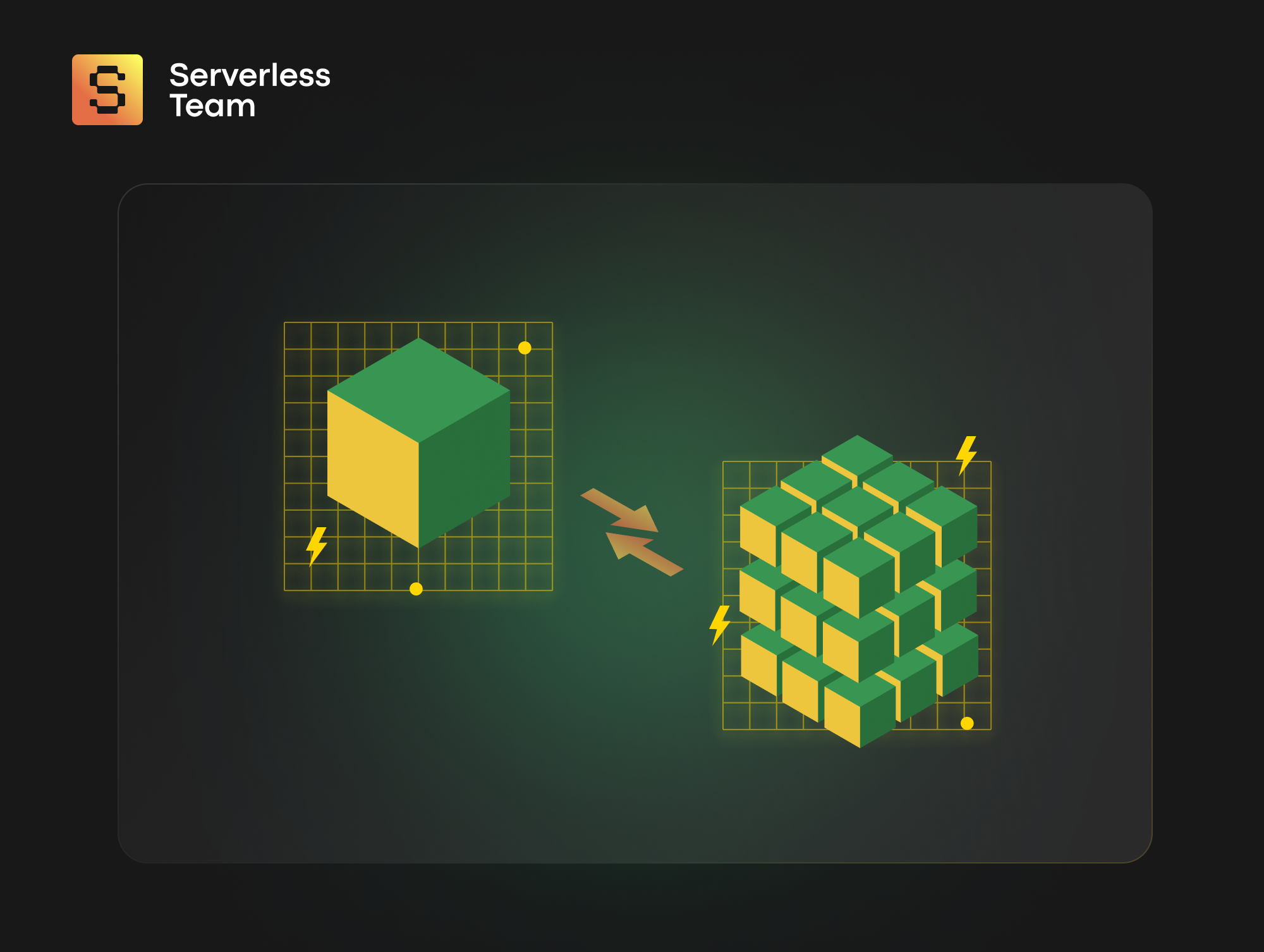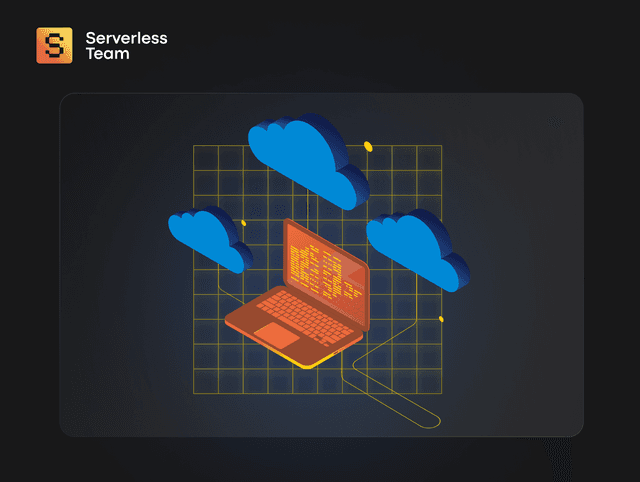Either you’re building an app from scratch or looking at that legacy code, trying not to tear your hair out while updating it. If it’s a former, what is there even to think about? Microservices rock. If it’s the latter, we at Team Serverless feel your pain. However, it’s not all that black & white between monolithic and microservices architecture.
Despite having a clear preference, we can’t say that microservices architecture is better for everything. Even though it sure can be a pain in one’s apple bottom, the monolith has its benefits. In this article, we will explore monolithic and microservices architecture types and what’s so cool (and not cool) about them.
If you want something more detailed, check out how we helped MasterStream move to microservices architecture and why we actually did the opposite for a fintech aggregator.
So, let’s dive in.

We take care of serverless development so you can focus on your business
Don't want to wait for our site launch? Let's talk about your idea right now.


Explaining Monolithic Architecture
Monolith is literally a large block of stone, which describes quite well how a monolith architecture is organized. When it comes to monolithic architecture, all the components and their associated friends have to be present for the code to be executed or compiled, and for the software to run. It's a one-tiered affair, like a big application potluck where everyone brings their specialties. But, as you can imagine, things can get a bit unwieldy over time. These monolithic applications tend to accumulate large codebases, which can become a hassle to manage.
Here's the tricky part: when you want to update one component in a monolithic setup, it can cause a domino effect. Other elements need to be rewritten, and you'll have to recompile and test the entire application. It's like trying to change a single lightbulb when the whole chandelier needs a makeover! This process can be time-consuming and put a damper on the agility and speed of your development teams.
Now, despite these challenges, monolithic software still has its fan club. It offers some advantages and has been around since the early days of software development. So, we can't simply toss it aside when those legacy applications still need some love and updates.
Still Somewhat Vague? Take a Look at an Example
Imagine a digital marketplace bustling with activity. Our monolithic e-commerce app includes essential components like a web server, a load balancer, a catalog service for product images, an ordering system, a payment function, and a shipping component.
But here's where the plot thickens: if changes are needed for just one component, brace yourself for a cascade of code changes for all the other affected parts. It's like trying to untangle a knotted string of holiday lights—it can be quite the challenge, and you don’t want to be the one responsible for it. This architecture type goes against the agile approach favored by today's developers, who strive for quicker iterations and flexibility.
So it's important to consider the trade-offs when working with monolithic architectures. While they offer a consolidated and comprehensive solution, they can pose challenges regarding scalability and agility.

Kyrylo Kozak
CEO, Co-founderGet your project estimation!

Pros and Cons Monolithic Architecture

-
Pros of Monolithic Architecture
- Less cross-cutting concerns: Say goodbye to headaches caused by cross-cutting concerns like logging, caching, and performance monitoring. In a monolithic app, these worries are confined to a single space, making them easier to handle.
- Seamless debugging and testing: When it's monolithic vs. microservices in the debugging and testing arena, the single-tiered approach steals the show. Since a monolithic app operates as one harmonious unit, you can swiftly run end-to-end tests without breaking a sweat.
- Prompt and simple deployment: With monolithic architecture, you can skip the deployment frenzy. Drop that mighty file or directory, and you're ready.
- Easier development: Since monolith has been the industry standard for a long time, the majority of software engineers have a skillset and the know-how to navigate the monolithic realm.
-
Cons of Monolithic Architecture
- Code complexity: Building a towering structure is cool until it starts shaking like a dancing cactus. Similarly, as a monolithic app grows, it can become a complex, tough to understand and maintain. That large codebase within a single application can give be tough to disentangle.
- Highly interdependent components: Making changes in a vast and intricate monolithic application can be immensely difficult. With high coupling, any code tweak sets off a chain reaction affecting the entire system, so working with it requires precise coordination. And we know that legacy apps and well-written documentation are not mutually inclusive.
- Limited scalability: You can‘t scale individual software components independently with a monolithic architecture, so you’re stuck scaling the entire application.
- New technology barriers: To introduce any updated technology in a monolithic app, you’ll have to rewrite the whole software, and that's daunting. Not to mention expensive.
Explaining Microservices Architecture
Microservices architecture is a well-orchestrated ensemble of modular components called microservices, working harmoniously to achieve specific business goals.
Each microservice is like a small but mighty building block within a larger service. It operates independently, with a clear and concise interface to communicate with other microservices. This modular approach enables scalability on a granular level. You can scale individual components of your application based on their specific needs without affecting the rest of the system.
Moreover, the beauty of microservices lies in their flexibility. You can add, remove, rename, reconfigure, modify, and rearrange them without causing a domino effect on the other parts of the software.
Now, let's draw a sharp contrast with the monolithic architecture. In the monolithic world, elements of the program are tightly interwoven and interdependent. Changing one element often requires addressing the entire program, while microservices offer you modularity and flexibility of microservices where any individual component can be tweaked easily.
Here are the key characteristics of microservice architecture:
Specific
Each microservice has a specific purpose and is designed to accomplish a particular function or address a specific requirement.
Separated:
In an ideal scenario, microservices have minimal dependencies, although they still engage in frequent and extensive communication.
Resilient:
Microservices are designed to be fault-tolerant, ensuring that a single service failure doesn't bring down the entire application, like a safety net.
API-driven:
APIs take center stage in a microservices architecture. They facilitate seamless communication between the services, acting as gateways for interaction.
Independent:
Ideally, each microservice has its own database or storage volume, promoting data separation and ensuring autonomy, and preventing data entanglement.
Pros and Cons Microservices Architecture
Now, let's look at why you can decide to go or not to go forward with microservices architecture:

-
Pros of Microservices Architecture
- Scalability and Flexibility: Microservices allow for independent scaling of individual components based on their specific needs. You can allocate resources where they are most required, resulting in better performance and cost-efficiency.
- Modularity and Agility: With microservices, applications are broken down into smaller, independent services. This modularity enables faster development, deployment, and iteration cycles. Each team can work on different microservices simultaneously, promoting parallel development and efficient updates.
- Technology Diversity: Microservices allow you to use different technologies and programming languages for different services. This freedom enables you to choose the best tool for each specific job.
- Fault Isolation: Microservices are designed to be resilient. If one service fails, it doesn't bring down the entire system. The failure is contained within the affected microservice, ensuring the rest of the application continues functioning.
-
Cons of Microservices Architecture
- Increased Complexity:The overall complexity can increase as you break down an application into smaller services. Communication between microservices requires careful management, and maintaining consistency and data integrity can be more challenging.
- Distributed System Challenges:With microservices, you're dealing with a distributed system. This introduces additional complexities such as network latency, potential points of failure, and the need for robust error handling and monitoring, leaving no room for hiccups.
- Operational Overhead:Deploying and managing a microservices architecture may require additional operational efforts. Each microservice needs to be monitored, scaled, and taken care of individually.
- Development and Testing Dependencies:Testing and debugging in a microservices environment can be more intricate. Services may depend on other services or external APIs, making it essential to set up comprehensive testing and mocking strategies.
Comparing Monolith to Microservices Architecture
So which one is better, you may ask? The answer is not that simple. You have to consider individual business needs before making a decision.

The industry is witnessing a shift from monolithic architectures to microservices, and for a good reason. It's challenging to accommodate all the capabilities that businesses desire within a single platform. Instead, companies are finding a more promising approach by deploying the most suitable solutions for their specific needs.
This shift allows businesses to tailor their technology stack to their unique requirements, unlocking a better overall experience. It's like handpicking the perfect tools from a toolbox to tackle different tasks, ensuring optimal performance and compatibility.
Factors to Consider When Choosing an Architecture
While you may not want to hear it, there are a lot of supportive arguments for using a monolith architecture instead of a set of microservices:
-
It’s a small or low-traffic application.
If your application is small in scale or experiences low traffic, the added complexity and overhead of microservices may not be justified. The benefits may not outweigh the costs in such cases.
-
There are no scalability issues.
If your application is not facing scalability challenges and can handle the current workload efficiently, breaking it into microservices is not necessary. The monolithic architecture is good enough for applications with stable and predictable usage patterns.
-
Your team lacks expertise.
If your team lacks the necessary knowledge in distributed systems, microservices, and containerization, it’s best to avoid this type of architecture. It will only lead to implementation challenges and maintenance issues.
-
Code has many complex dependencies.
If an application has intricate and tightly coupled dependencies that would be difficult to reproduce in a microservices architecture, it’s more practical to stick with the monolithic approach. Rewriting or refactoring the application to accommodate microservices will introduce more complexity and potential issues.
-
You want to avoid high maintenance costs.
Breaking a monolithic application into microservices can be a significant investment in terms of time, resources, and potential disruption. If the cost outweighs the benefits or doesn't align with your business goals, stick with the monolith.
-
You store tons of sensitive info.
If your application handles sensitive data, microservices may introduce additional security concerns. The distributed nature of microservices requires careful consideration of access control, data isolation, and secure communication. Assess whether the added security risks are worth the potential benefits.
Okay, now that I’ve said all that, it’s time to be a good sport and speak up for microservices.
-
Scalability.
Each microservice can be independently scaled, allowing you to allocate resources where they are most needed. If your monolithic service struggles with scalability despite implementing various measures, breaking it into microservices is a good idea.
-
Flexibility.
When the monolithic service becomes difficult to change or extend, microservices provide flexibility. Independent development and deployment of different functional areas enable faster iterations and adaptability to evolving requirements.
-
Resilience.
If maintaining the monolithic service becomes challenging, microservices offer resilience. Managing and monitoring individual functional areas independently ensures that failures are contained, minimizing the impact on the overall application.
-
Different teams and technologies.
If different teams are responsible for different parts of the application or specific areas require different technology stacks, microservices streamline independent work and encourage using the best-suited technologies for each area.
-
Security (with considerations).
While introducing microservices may have additional security considerations, they also offer benefits. Granular access control and data isolation can enhance security measures. However, careful planning and implementation are necessary to ensure robust protection.
When considering the adoption of microservices, weigh the benefits against your application's specific needs and challenges. Assess scalability, flexibility, resilience, team dynamics, technology requirements, and security implications to make an informed decision. It’s better to take some time to think before taking a leap of faith.
Our Experience With Both
From Monolith to Microservices
When we examined the legacy monolith architecture of MasterStream, a company specializing in telecom solutions, it lacked a modern touch that could automate and simplify its supply chain processes. The client needed us to replace it with a scalable, cost-effective, and reliable solution that efficiently connects providers, agents, and customers.
So instead of rewriting the whole monolith, we went with a brand new microservices architecture to meet the evolving demands of MasterStream's customers.
The revamped architecture stimulated smooth communication among providers, agents, and customers, streamlining and automating the telecom supply chain. With on-demand resource allocation, scalable data processing, and robust security measures, the client's platform got a boost in performance, increased flexibility, and heightened reliability.
From Microservices to Monolith
Initially, our main task was to migrate the platform's data from MongoDB to Postgres, transitioning from a NoSQL to a SQL database. However, our product audit uncovered a more significant performance issue affecting the system.
Inquiries to their backend took a whopping 1.5 seconds to respond, causing frontend page load times of 12 seconds or more. This sluggishness seriously impacted user experience, making navigation between pages frustratingly slow.
Upon delving deeper into the existing architecture, we discovered that multiple Lambda functions were redundantly performing the same tasks. This setup wasn't ideal for a microservices architecture. To tackle the problem, we took a different approach and migrated the platform to a monolithic architecture, consolidating all the application logic into a single Lambda function.
This strategic move led to significant improvements in performance, resulting in snappy response times and a seamless user experience. The platform is now running more efficiently, delivering faster results and happier users.
Wrapping up
Making the right architectural choice for your app is no easy task, especially regarding monolithic and microservices architecture. While microservices may seem like the popular choice, it's important to consider the specific needs of your business.
Make sure to evaluate factors like structure, scalability, development speed, deployment approach, fault isolation, technology diversity, complexity management, communication patterns, and testing strategies. These considerations will help you decide based on your unique requirements.
If you need further guidance or have specific questions about your app's architecture, our team is here to assist you. Reach out, and let’s together choose what architecture suits your app best.





